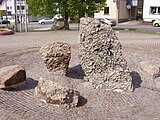Holzer conglomerate
The Holzer conglomerate is a layer of rock that comes to light near the Heusweiler-Holz district in Saarland . This conglomerate has a concrete-like appearance and hardness , but is of natural origin. The Holzer conglomerate belongs to the up to 5100 meters thick Saarland - Lorraine Carboniferous , the deposits of which were formed around 310 to 300 million years ago.
- Holzer conglomerate at Holzer Platz in Heusweiler-Holz
The entire strata profile of the Saar carbon from the time of the Upper Carboniferous consists of 560 coal seams , which make a total of around 120 meters of hard coal . The Holzer conglomerate separates the 3100-meter-thick so-called Saarbrücker strata , which emerge to the south, from the approximately 2000-meter-thick Ottweiler strata above .
The entire geological structure stretches along the ridge of the Riegelsberg from southeast to northwest and, due to tectonic faults, has now tilted in the area of wood at an angle of 21 to 25 degrees to the north. Three different layers can be identified in the Holzer conglomerate: At the bottom there is a gray coarse bed, in the middle a reddish, finer-grained layer and at the top a reddish coarse bed.
The Holzer conglomerate is an important separating and guiding layer for geologists . It is made up of debris from the Vosges and Hunsrück mountains , which were carried away by water millions of years ago and were able to settle in a large basin. The well-rounded grain fraction consists of 97% quartzite ( Lower Devonian Taunus quartzite ) with a grain size of 10 to 90 centimeters. Layers of lime and sand are switched on at various points .
The extent of the conglomerate deposit covers an area of 50 by 175 kilometers. The exact origin is not yet fully understood, but the deposits are similar to those that occur in today's overgrown river systems. The large area has led various investigators to suspect that the Holzer conglomerate could have emerged from a large-scale natural disaster.
As a result of the pressure of the layers of earth that were later deposited over it, both the coal and the intermediate layer of rubble of the Holzer conglomerate were created. The strength of the rock used to make it almost impossible for miners to penetrate this layer in order to get to the other layers of coal below. The inexperienced observer may consider the rocks lying around in the forest today to be criminally deposited concrete rubble.
Individual evidence
- ↑ a b c Saarkohlenwald. (No longer available online.) Association for Industrial Culture and History Heusweiler-Dilsburg eV, archived from the original on September 24, 2015 ; Retrieved March 6, 2010 .
- ↑ Mining in the Köllertal - The Von der Heydt mine. Retrieved March 6, 2010 .
- ↑ Manfred Stephan: Sediment formation during the flood disaster in the Ore Mountains (Saxony). Comparison with coarse fillings of the earth's past . In: Studiengemeinschaft Wort und Wissen (Ed.): Studium Integrale Journal . No. 1 , May 2004, p. 11-19 ( online [accessed March 6, 2010]).
- ↑ Hans Wilhelm Weingardt: The Westphalian-Stefan border in the Saar Carboniferous, new observations, investigations and findings. 7e Congrès International sur la Stratigrafie et Géologique du Carbonifère, Krefeld 1975, pp. 375-382.



